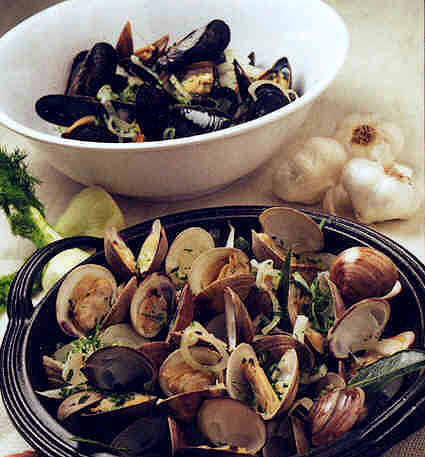|







|
 Clams
are very popular in the United States and offer a wide variety of
preparation alternatives. The soft-shell clam
from the northeast U.S. all the way to France is also called Longneck
Steamers or Sand Gaper. This clam has a thick protruding neck and the
shell never is able to shut tightly. Clams
are very popular in the United States and offer a wide variety of
preparation alternatives. The soft-shell clam
from the northeast U.S. all the way to France is also called Longneck
Steamers or Sand Gaper. This clam has a thick protruding neck and the
shell never is able to shut tightly.
Clams with hard shells come
in a variety of shapes and sizes from stubby round to long razor shapes.
Though the shells may be white to purple, the flesh is usually beige to
cream in color with a red coral speckle occasionally.
Smaller hard shells are eaten raw and larger ones, due to their tough
nature, are cut or chopped and used! in chowders, fritters and sauces.
Clams are marketed already shucked, fresh or frozen,
frozen chopped clams and frozen clam nectar are packed in four pound
containers, shucked clam meat is also available as whole or as chopped
frozen. Canned clam broth and clam meat is also available in #5 and #10
cans as canned.
| Name
|
Market
Form |
Weight
|
Cooking
Method |
|
Hard Shell Clams |
Live
fresh,
frozen shucked, |
80
per bushel
100-250 per gal |
Steam in shell, Raw in half-shell, |
|
Soft Shell Clams |
in
shell,
canned smoked |
45
per bushel
200- 700 per gal. |
Fry, breaded and fried, bake, broil, |
Nutritional Value: 3.5 oz./100 grams
Clams 60 calories, 9 grams protein, 3 grams carbohydrates, 1 gram fat
   

|

 Clams
are very popular in the United States and offer a wide variety of
preparation alternatives. The
Clams
are very popular in the United States and offer a wide variety of
preparation alternatives. The